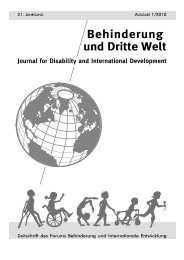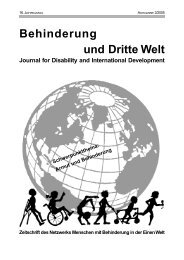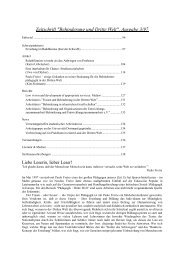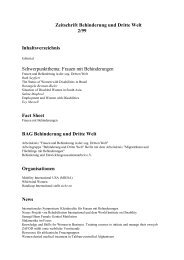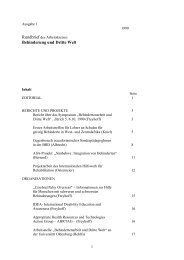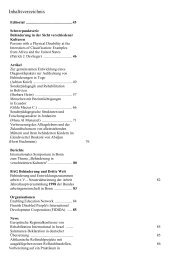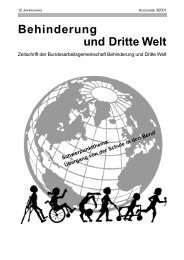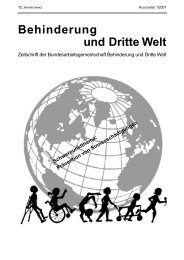Behinderung und internationale Entwicklung Disability and ...
Behinderung und internationale Entwicklung Disability and ...
Behinderung und internationale Entwicklung Disability and ...
You also want an ePaper? Increase the reach of your titles
YUMPU automatically turns print PDFs into web optimized ePapers that Google loves.
K URZMELDUNGEN/ANNOUNCEMENTSAdults <strong>and</strong> Children with Disabilities atMuch Higher Risk of ViolenceBoth children <strong>and</strong> adults with disabilities are at much higherrisk of violence than their non-disabled peers, accordingto two systematic reviews recently published in theLancet. The reviews were carried out by Liverpool JohnMoores University’s Centre for Public Health, a WHO CollaboratingCentre for Violence Prevention, <strong>and</strong> WHO’sDepartment of Violence <strong>and</strong> Injury Prevention <strong>and</strong> <strong>Disability</strong>.These are the first studies to confirm the magnitude ofthe problem <strong>and</strong> they provide the strongest available evidenceon violence against children <strong>and</strong> adults with disabilities.They also highlight the lack of data on this topicfrom low- <strong>and</strong> middle-income countries. The review onthe prevalence <strong>and</strong> risk of violence against children withdisabilities, published in July 2012, fo<strong>und</strong> that overallchildren with disabilities are almost four times more likelyto experience violence than non-disabled children. The reviewindicated that children with disabilities are 3.7 timesmore likely than non-disabled children to be victims ofany sort of violence, 3.6 times more likely to be victims ofphysical violence, <strong>and</strong> 2.9 times more likely to be victimsof sexual violence. Children with mental or intellectual impairmentsappear to be among the most vulnerable, with4.6 times the risk of sexual violence than their non-disabledpeers (Prevalence <strong>and</strong> Risk of Violence Against Childrenwith Disabilities: A Systematic Review <strong>and</strong> Meta-Analysisof Observational Studies, available at: http://press.thelancet.com/childrendisabilities.pdf).The systematic review on violence against adults withdisabilities, published in February 2012, fo<strong>und</strong> that overallthey are 1.5 times more likely to be a victim of violencethan those without a disability, while those with mentalhealth conditions are at nearly four times the risk of experiencingviolence (Prevalence <strong>and</strong> Risk of Violence AgainstAdults with Disabilities: A Systematic Review <strong>and</strong> Meta-Analysis of Observational Studies, available at:www.who.int/disabilities/publications/violence_children_lancet.pdf).“The results of these reviews prove that people withdisabilities are disproportionately vulnerable to violence,<strong>and</strong> their needs have been neglected for far too long,”notes Dr Etienne Krug, Director of WHO’s Department ofViolence <strong>and</strong> Injury Prevention <strong>and</strong> <strong>Disability</strong>. “We knowthat specific strategies exist to prevent violence <strong>and</strong> mitigateits consequences. We now need to determine if thesealso work for children <strong>and</strong> adults with disabilities. Anagenda needs to be set for action”.Factors which place people with disabilities at higherrisk of violence include stigma, discrimination, <strong>and</strong>ignorance about disability, as well as a lack of social supportfor those who care for them. Placement of peoplewith disabilities in institutions also increases their vulnerabilityto violence. In these settings <strong>and</strong> elsewhere, peoplewith communication impairments are hampered in theirability to disclose abusive experiences."The impact of a child's disability on their quality of lifeis very much dependent on the way other individuals treatthem,” stresses Dr Mark Bellis, Director of the Centre forPublic Health at Liverpool John Moores University, a WHOCollaborating Centre for Violence Prevention, <strong>and</strong> leadresearcher on the review. “This research establishes thatthe risk of violence to children with disabilities is routinelythree to four times higher than that to non-disabled children.It is the duty of government <strong>and</strong> civil society to ensurethat such victimization is exposed <strong>and</strong> prevented."Proven <strong>and</strong> promising programmes to prevent violenceagainst non-disabled children <strong>and</strong> adults – reviewed inWHO’s Violence prevention: the evidence, preventingchild maltreatment, <strong>and</strong> preventing intimate partner <strong>and</strong>sexual violence against women – should be implementedfor children <strong>and</strong> adults with disabilities, <strong>and</strong> their effectivenessevaluated as a matter of priority.The United Nations Convention on the Rights of Personswith Disabilities reinforces the need to protect therights of children <strong>and</strong> adults with disabilities <strong>and</strong> ensuretheir full <strong>and</strong> equal participation in society. This includesavoiding the adverse experiences resulting from violence,which are known to have a wide range of detrimentalconsequences for health <strong>and</strong> well-being. When preventionfails, care <strong>and</strong> support for children <strong>and</strong> adults who are victimsof violence are vital to their recovery. The WHO/World Bank World report on disability outlines what worksin improving health <strong>and</strong> social participation of people withdisabilities <strong>and</strong> promotes deinstitutionalisation.Information: http://who.int/disabilities/violence/en/index.html.Inaugural Forum on the Global Partnershipon Children with DisabilitiesOn September 14 th to 15 th , UNICEF hosted the first Forumon the Global Partnership on Children with Disabilities.240 participants representing more than 100 organisationsfrom across the world participated. They discussedhow the rights <strong>and</strong> needs of children with disabilitiesshould be prioritised in development efforts.The Forum included a high-level panel discussion onhow to realise equity <strong>and</strong> inclusion for children with disabilitiesin the post-2015 development agenda, as the targetdate for the Millennium Development Goals (MDGs) isfast approaching.During the Forum partners identified concrete strategiesto include disability on global agendas, in areas suchas education, nutrition, <strong>and</strong> humanitarian action. Partnersfrom seven countries (Azerbaijan, Bangladesh, Haiti, Malawi,Mozambique, Rw<strong>and</strong>a, Turkey) agreed on collaborationin the region covering Central <strong>and</strong> Eastern Europe<strong>and</strong> the Commonwealth of Independent States. Youth activistsalso made their voices heard. Abia Akram, the Coordinatorof the Global Network of Emerging Young WomenLeaders with Disabilities, spoke at the opening of theForum saying, “Girls <strong>and</strong> women with disabilities should34<strong>Behinderung</strong> <strong>und</strong> <strong>internationale</strong> <strong>Entwicklung</strong> 3/2012<strong>Disability</strong> <strong>and</strong> International Development



